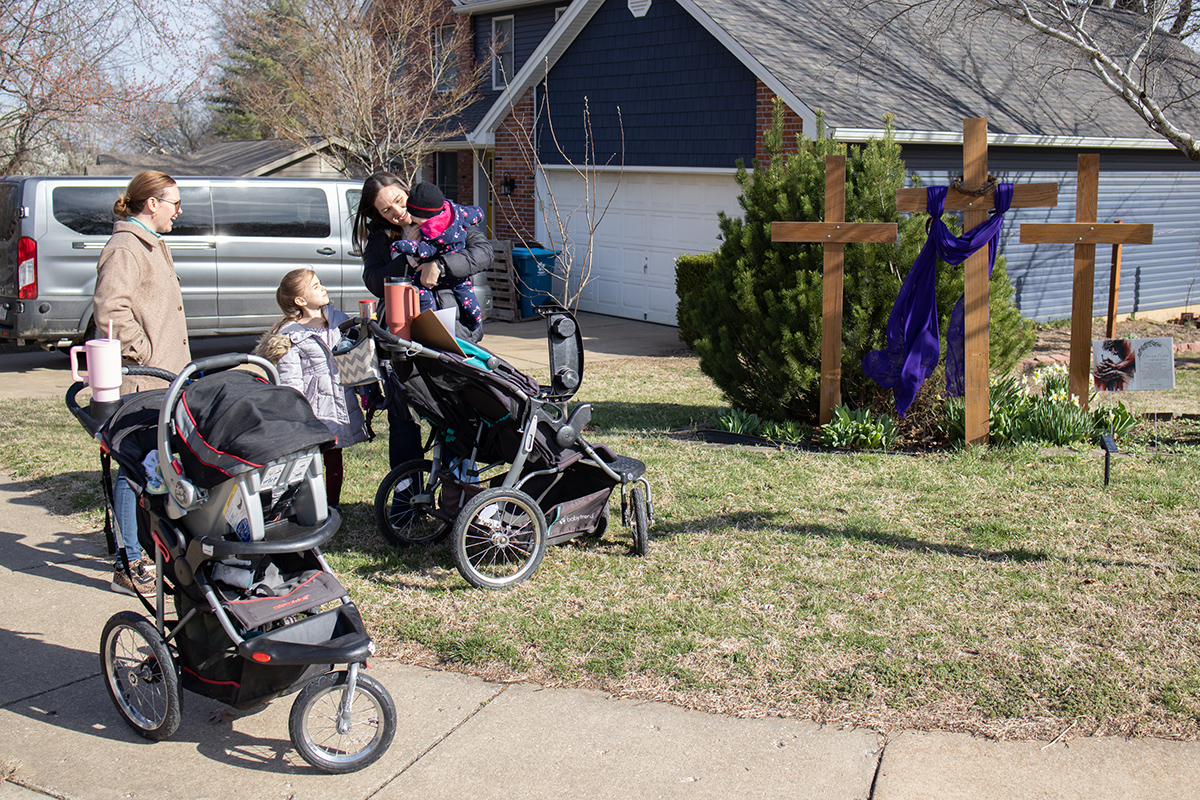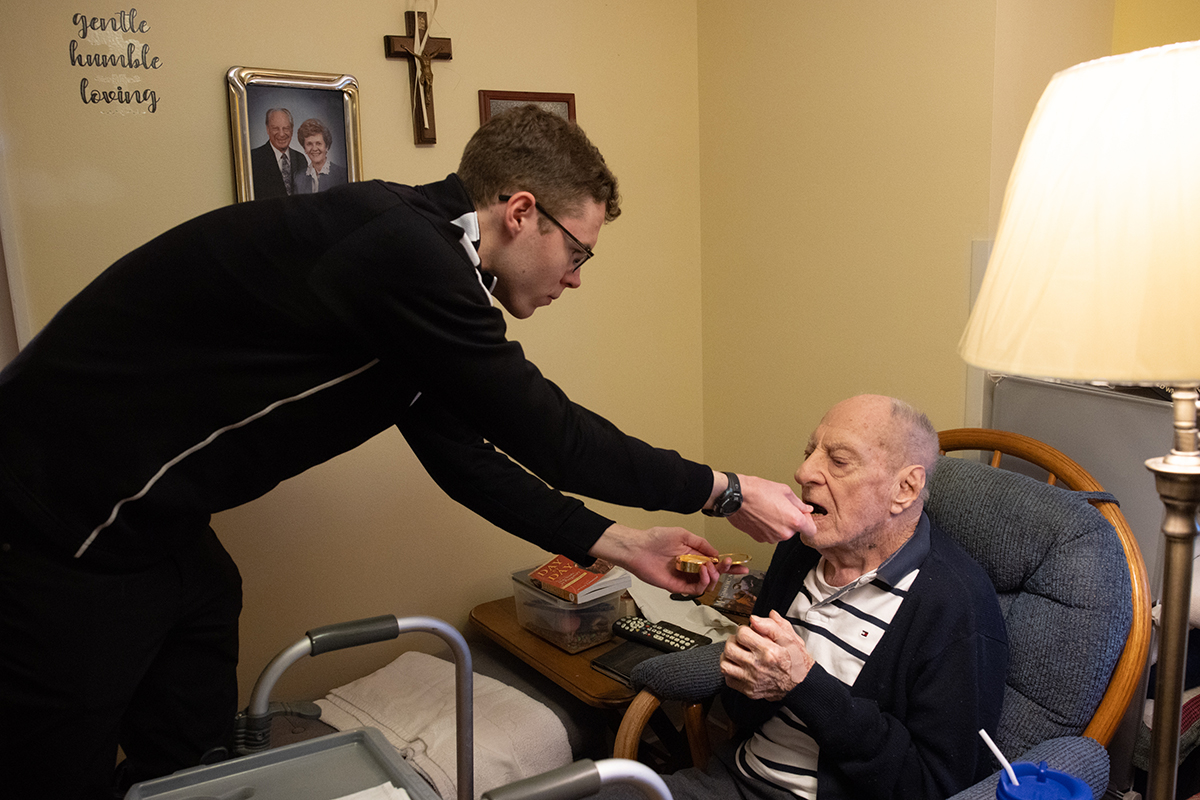Iconography workshop at St. Louis Priory School introduces students to the mysteries of faith and beauty and truth of religious art

Benedictine monk teaches iconography workshop, helping students become more deeply connected to the mystery of faith
Father Alex Echeandia Loro has shared his love for iconography all over the world, from his native Peru to Colombia, England and Ukraine — and now St. Louis.

The Benedictine monk and master iconographer visited Saint Louis Priory School in June for a weeklong workshop on icon writing. He came at the invitation of Priory headmaster Father Cuthbert Elliott, OSB, who befriended Father Alex during their monastic studies in Oxford, England, years ago.
Ten participants honed their skills in an art studio classroom at Priory. By the end of the week, participants walked away with a handcrafted icon of Christ Pantocrator, a representation of Christ as an all-powerful ruler: Creator, Savior and Judge. It was among the first images of Christ, dating from around the sixth century.
While learning the techniques of writing an icon, students spent time in prayer and reflection — and hopefully completed the workshop with a greater appreciation for the spiritual aspects of iconography, Father Alex said.
“I hope it improves their prayer,” he said. “The iconographer becomes an instrument, a medium of grace. When you talk about icons, you are really connecting with a mystery. That mystery becomes very deep if you pray in front of it.”
A microcosm of creation
Students began preparing an 8- by 10-inch piece of nonresinous wood (which Father Alex sourced from Romania) with thin layers of gesso, which acts as a primer. Using a printed image, Christ’s face was traced with a sketching crayon and transferred to the wood.
Using an oil-based adhesive, gold leaf was applied to the wood to illuminate three parts behind Christ’s head to represent the cross featured in the Christ Pantocrator icon.

Students then used a tempera paint mixed from egg yolk, vinegar and powdered pigments derived from natural sources, such as stone and dirt that Father Alex sourced from the United Kingdom.
Iconography dates back to the early Church and became prominent in the Eastern Church. The images found in the Christian Catacombs of Rome, dating back to around the second century, are believed to be some of the earliest icons.
“They painted what they believed when they were persecuted,” Father Alex said. “They were painting the mysteries — Christ the Good Shepherd, the Annunciation — different paintings on the walls. It was a way to communicate what we believe.”
From Peru to master iconographer
Father Alex was introduced to iconography nearly 20 years ago and trained for six months as a novice at Guatapé, Medellin, Colombia. He continued training at The Prince’s Foundation School of Traditional Arts in England and Ukrainian Catholic University in Lviv, Ukraine.
Father Alex uses his talents to support the Benedictine Monastery of the Incarnation in Lima, Peru, where he serves as the community’s superior. Proceeds from commissioned work and workshops he’s held in the United Kingdom — and now in St. Louis — support the community in Lima.
Father Alex said that some people describe an icon as a “window,” where one can enter into the mystery of faith through contemplation. “Different icons show you different scenes of eternity,” he said. “You can use your reasoning, your mind, to understand the icon and then pray through it, and also be captured by the beauty of it.”
Others describe iconography as a “door,” because the mystery comes to you. “God is coming to you through contemplating the icon,” he said. The prayer is not “a monologue about the things you have done in your life, or need, or are sorry for.”

Iconography presents an opportunity to open the door and receive the word of God. “It’s more than looking at a nice picture — it’s more about listening,” Father Alex said. “And you need to develop that side of the prayer — we forget the second part.”
The Liturgy of the Hours and the sacraments define and direct Father Alex’s life in a cycle of “Ora et Labora” (prayer and work), according to the Rule of St. Benedict. Writing icons is a reflection of those two elements — prayer and the work of human hands, he said.
A lesson in the virtue of patience
Amber Dennison learned about the workshop through the bulletin at her parish, St. Anselm in Creve Coeur. She entered the Catholic Church 25 years ago when she married her husband. Iconography — and saints for that matter — weren’t something that she learned much about in her Protestant upbringing.
“I wanted to learn more about the history of icons,” she said. She also said she’s found herself paying more attention to the details of an icon and the significance of what they mean. “Like in the image of Perpetual Help, (Jesus’) shoes are hanging off Him,” she said. “I wonder why that is? They have stories behind them, and there’s a lot of thought put into it. It’s a way to express your faith in an image.”
Karen Pfeifer of St. Nicholas Parish in O’Fallon, Illinois, is an accomplished calligraphist (she’s president of the St. Louis Calligraphy Guild) and always wanted to try her hand at iconography.
“I’ve always been fascinated with them, and they look so simple to do … but when you really look with an artist’s eye, I think you see that it’s not that simple,” Pfeifer said. “Having a visual image, it’s not that you’re worshiping the image, but it’s helping you to visualize that person’s life and what they meant to others going through their trials and becoming a saint.”
There are definite parallels between the process of writing an icon and faith, said Jon-Pierre Mitchom, director of diversity, equity and inclusion at Priory, who also participated in the workshop.
Take for instance the fine layers of paint that are applied as part of the process of writing an icon and how that might compare to the subtle ways in which God is moving in our life, he said.
“A lot of times we’re not noticing how God is moving in our life,” Mitchom said. “This has taught me a lot about the virtue of patience, the subtleties of the process and how that parallels our walk with God. Over time, those subtleties can have a great impact.”

The technique of laying down thin layers of paint is “almost like you have to have faith that you’re putting it down,” said Mary Claire MacDonald, who teaches medieval arts at Priory. “You can’t see it, but once you can do it again, you barely see it. And then you do it again, and all of a sudden, it’s like, wow, that’s huge.”
MacDonald has previous experience writing icons and said the process is an exercise in the virtue of patience. “It’s deeply comforting and a physical reminder of God’s presence,” she said.
>> How to pray with an icon
Benedictine Father Alex Echeandia Loro gives these tips for praying with an icon:
• Learn how to interpret an icon: Everything in an icon is symbolic and points to a spiritual truth about God. Icons of the saints typically incorporate symbols that create a spiritual “portrait,” reflecting attributes or events that contributed to the person’s sainthood. Father Alex noted that icons are “written,” which means that one needs to learn how to “read” them by learning the meaning behind the details. With that increases the meaning of the time spent in prayer.
• Look for significance in the facial features: Every icon relates to the primary Icon, Christ. The facial features of Mary and the saints typically feature a small mouth, representing the prudence of Christ. By contrast, the eyes and ears are larger than the mouth, showing that they are listening to the Word through the Holy Spirit and contemplating the Beatific Vision. “The saints are always contemplating God because they’re saints,” Father Alex said. “You can enter into that dimension through their features.”
• Contemplate: It’s important to leave space to listen to what the Lord might be saying through the icon. Remain quiet in your prayer and disposed to the prompts where the Lord is leading you.”He wants to be manifested through the image,” Father Alex said. “When someone is praying in front of the icon, he or she is encountering the mysteries of Christ and the saints.”
>> Christ Pantocrator

Christ as Pantocrator, meaning “almighty” or “all-powerful,” is one of the most recognized depictions of Jesus, the oldest of which is believed to be a sixth century icon at St. Catherine’s Monastery on Mt. Sinai, Egypt.
Pantocrator is derived from the Greek words pas (“all”) and kratos (“might” or “power”). The icon represents Christ as an all-powerful ruler: Creator, Savior and Judge. The depiction of His face contributes to the idea that God sees all. His eyes and expression are generally stern and distant.
In one version of the icon, Christ holds the New Testament in His left hand and makes a gesture of blessing or teaching with His right. His name is written on each side of His head with IC and XC.
Rules and prayers for iconographers
• Before starting work, make the sign of the cross; pray in silence and pardon your enemies.
• Work with care on every detail of your icon, as if you were working in front of the Lord Himself.
• During work, pray in order to strengthen yourself physically and spiritually; avoid all useless words and keep silence.
• Pray in particular to the saint whose face you’re painting. Keep your mind from distractions, and the saint will be close to you.
• When your icon is finished, thank God that His mercy granted you the grace to paint the holy image.
• Have your icon blessed by putting it on the holy table of your parish church. Be the first to pray before it, before giving it to others.
Father Alex Echeandia Loro has shared his love for iconography all over the world, from his native Peru to Colombia, England and Ukraine — and now St. Louis. Father Alex … Iconography workshop at St. Louis Priory School introduces students to the mysteries of faith and beauty and truth of religious art
Subscribe to Read All St. Louis Review Stories
All readers receive 5 stories to read free per month. After that, readers will need to be logged in.
If you are currently receive the St. Louis Review at your home or office, please send your name and address (and subscriber id if you know it) to subscriptions@stlouisreview.com to get your login information.
If you are not currently a subscriber to the St. Louis Review, please contact subscriptions@stlouisreview.com for information on how to subscribe.







